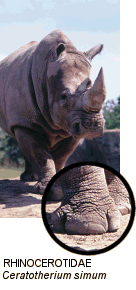 |
The name "rhinoceros" translates directly from Greek as "nose-horn" - an
apt name, as all five extant species of rhinos possess at least one horn
(sometimes two) growing from the top side of the nose. Unlike the horns of
bovid artiodactyls, the "horns" of the rhinoceroses lack a bony core and
are comprised of compressed hair. The horns have purported medicinal properties
and are also used to make traditional ornaments -as a result, all rhinoceros
species have been hunted to the brink of extinction. The Javan rhino
(Rhinoceros sondaicus) is one of the most endangered species of mammals
on earth today, with an estimated population of 60 individuals. The northern
white rhino (Ceratotherium simum cottoni) is critically endangered
with fewer than 30 wild individuals remaining.
The Rhinocerotidae arose during the Eocene, likely from tapir-like ancestors. Rapidly colonizing Eurasia and North America, and then invading Africa during the Miocene, rhinos became a highly successful group: at least 30 genera are known in the fossil record. Modern rhinoceroses are restricted to tropical and subtropical climates, but several cold-adapted species once existed, including the woolly rhinoceros (Coelodonta) from the Pleistocene. Today, rhinos are found in eastern and southern Africa and to southeast Asia. African rhinoceroses tend to inhabit more open terrain than the forest-dwelling Asian species. The skin is tough and thick, falling into plate-like folds; in most species it is bare or sparsely haired, but the Sumatran rhinoceros (Dicerorhinus sumatrensis) has long hair on the back and sides. The nasal bones of the skull are expanded forward to support the (anterior) horn. The posterior horn (when present) is on the frontal bones. The dental formula is I 0-1/0-2, C 0/0-1, P 3-4/3-4, M 3/3 x 2 = 24-36. |
(From Tougard et al., 2001)
| Diceros bicornis
Ceratotherium simum Rhinoceros sondaicus |
or jump to the Rhinocerotidae Species List